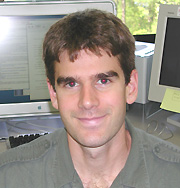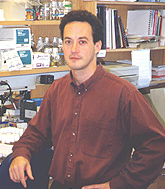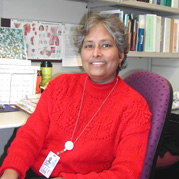
| T H E N I H C A T A L Y S T | M A R C H – A P R I L 2003 |
|
|
|
| P E O P L E |
RECENTLY
TENURED
 |
|
David
Dunson
|
David B. Dunson received his doctorate in biostatistics from Emory University in 1997 and then began his career as a research fellow at NIEHS working with colleagues Clarice Weinberg on methods for adjusting for measurement error in fertility studies and Joseph Haseman on methods for analysis of tumor data from transgenic mouse bioassays. He is currently an adjunct associate professor of biostatistics at the University of North Carolina at Chapel Hill and an adjunct associate professor of statistics and decision sciences at Duke University, in Durham, N.C., as well as a senior investigator in the Biostatistics Branch, Environmental Diseases and Medicine Program, NIEHS.
My research focuses on developing and applying improved statistical methods for the analysis of data from biomedical studies. Such data have become increasingly complex and multidimensional as researchers attempt to characterize the time-varying relationships among exposures and different health outcomes.
There is a pressing need for innovative statistical approaches that allow for missing, mismeasured, and censored observations, and for joint analyses of correlated outcomes having a variety of measurement scales (such as binary, categorical, or continuous). We have made substantial progress in addressing such problems using Bayesian hierarchical models and Markov chain Monte Carlo computation.
My work with latent variables and order restrictions has been particularly innovative and has resulted in major advances in the fields of fertility and reproductive epidemiology, developmental toxicology, and tumorigenesis. Parameter or shape constraints can be incorporated to limit the loss of efficiency typically associated with the use of nonparametric methods (for instance, for assessing a dose-response trend). However, novel methods of model fitting and inference need to be developed for analyses under such constraints.
One of the primary focuses of my research has been the development of general Bayesian methodology for order-restricted inference. Such methods are particularly useful in toxicology and epidemiology studies in which investigators are interested in the association between a health outcome and an exposure that can have multiple levels.
In addition to conducting theoretical research in statistics, I am also actively involved in answering several intriguing medical and public health questions. Recent studies carried out in collaboration with colleagues Donna Baird of NIEHS and Bernardo Colombo of the University of Padua in Italy showed that female fertility begins a noticeable decline in the mid to late 20s, whereas male fertility begins to decline in the mid 30s. Another finding—that more than half of couples diagnosed as infertile can conceive naturally in the second year of attempting pregnancy—has challenged the common practice of referring couples to assisted reproductive therapy after one year of unsuccessful attempts. Other interesting work in reproductive epidemiology includes collaboration with Baird on the NIEHS Uterine Fibroid Study, as well as work with NIEHS colleagues Weinberg, Baird, and Allen Wilcox on analyses of the North Carolina Early Pregnancy Study.
Ongoing research focuses on developing improved methods for factor analysis when outcome variables have a variety of measurement scales—including categorical, count, and event times—and when there is uncertainty in the correlation structure. Such improved methodology would greatly benefit studies of complex predictors of pregnancy outcomes, such as stress, bleeding, and exercise.
 |
|
Mark
Fortini
|
Mark Fortini received his Ph.D. from the University of California at Berkeley in 1990 and did postdoctoral work at Yale University in New Haven, Conn., from 1991 to 1996. Before moving to NIH, he was an associate professor of genetics at the University of Pennsylvania School of Medicine in Philadelphia. At NIH, he joined the Regulation of Cell Growth Laboratory at NCI-Frederick, where he is now a senior investigator.
My laboratory studies developmental signal transduction and cell-fate specification using the fruit fly, Drosophila. We are most interested in the signaling pathway controlled by the Notch receptor, a cell-surface protein that receives signals from neighboring cells, thereby allowing cells to adopt the correct differentiation program in response to their local environment.
Notch was first identified in the early 1900s through genetic studies in Drosophila. Embryological studies in the 1930s revealed that it plays a key role in sorting undifferentiated progenitor cells into neuronal and epidermal lineages. Subsequent work by many groups has shown that the Notch pathway is responsible for transmitting cell-fate instructions between cells during the development of many organisms, ranging from sea urchins and nematodes to humans.
In humans, Notch signaling is known to be important for organogenesis, for epithelial patterning, and for the proper differentiation of B- and T-cell lineages during immune system development. Altered forms of human Notch cause T-cell acute lymphoblastic leukemia and CADASIL (cerebral autosomal dominant arteriopathy with subcortical infarcts and leukoencephalopathy), an adult-onset syndrome that includes stroke and dementia.
Genetic lesions in the genes that encode ligands for Notch result in clinical developmental disorders such as Alagille syndrome (abnormalities in bile ducts, liver, and sometimes cardiovascular system, spinal column, eye, and kidneys of children) and spondylocostal dysostosis (multiple deformities of the ribs and vertebrae). Owing to the central role that Notch plays in the determination of many different cell types, this pathway is likely to be involved in the genesis and progression of many types of human cancer.
In earlier work, my colleagues and I focused on defining the molecules that act downstream of Notch to transmit the signal into the cell. In recent years, we have become more interested in complex proteolytic processing events that alter the Notch receptor during its synthesis and cell-surface activation. In particular, we have been studying a multimeric complex, called g-secretase, which was initially identified through human studies of families affected by a severe, early-onset form of inherited Alzheimer’s disease.
Remarkably, the g-secretase complex appears to play an analogous biochemical role in signaling by Notch and in Alzheimer’s disease pathogenesis. In the case of Notch, g-secretase cleaves the receptor at the cell surface in response to ligand binding, releasing a signaling fragment to the inside of the cell. This event is a normal part of the signaling pathway operation.
In Alzheimer’s disease, a different cell-surface protein, the amyloid precursor protein (APP)—which is likely to function normally as a cell-surface receptor like Notch—is cleaved by g-secretase. However, in this case, the proteolysis of APP leads to secretion of a small leftover "sticky peptide," b-amyloid, which accumulates in neurotoxic plaques in brain tissues of affected individuals.
Many researchers believe that the production of b-amyloid is the event that triggers the development of Alzheimer’s disease, eventually snowballing into the inflammatory responses and neurodegeneration that characterize the later stages of the illness.
Our goal is now to understand the properties of g-secretase and its involvement in Notch signaling in greater detail, using the powerful genetic and molecular approaches available in Drosophila.
One of the most unusual features of g-secretase is that it apparently cleaves its substrate proteins, such as Notch and APP, within their membrane-spanning segments, implying that g-secretase is able to promote the hydrolysis of peptide bonds despite the hydrophobic environment of cell membranes.
The large g-secretase complex has four major identified proteins (Presenilin, Nicastrin, Aph-1, and Pen-2), and we have identified mutations in the genes for most of them in Drosophila. We have shown that they are all essential for Notch signaling, and that they affect the ability of Notch to be cleaved in response to developmental signaling cues. We have also performed stepwise addition studies to investigate the individual functions of each protein in the complex.
Our goal is to understand the proteolytic function of g-secretase and its relationship to the intracellular trafficking of Notch during synthesis of the receptor. We are also exploring other approaches to identify additional proteins that are involved in developmental signaling, neuronal cell-fate specification, and neurodegeneration
 |
|
Brian
Oliver
|
Brian Oliver received his Ph.D. from Case Western Reserve University School of Medicine in Cleveland, Ohio, in 1988 and did postdoctoral work at Stanford University, Stanford, Calif., before taking a group leader position at the University of Marseille in France in 1991. In 1995 he joined NIDDK’s Laboratory of Cellular and Developmental Biology, where he is now senior investigator.
The humble fruit fly, Drosophila melanogaster, is an important model system, boasting facile genetics, complex organ systems, complex behaviors, and a sequenced genome. Fruit flies are easy to propagate and require little lab space. We and our collaborators at NHGRI, NIA, and Incyte Genomics have been involved in adding high-throughput genomics techniques, such as Expressed Sequence Tags (ESTs) and DNA microarrays, to our Drosophila toolkit and in making reagents for array production widely available to the worldwide Drosophila community.
While we have been active in developing technology, mostly we use fruit flies to address basic biological problems. Our long-term interest has been in determining how the sex of the germ line is established—in other words, how a germ line stem cell gives rise to either sperm or eggs. Stem cell development occurs in a defined niche. Our work suggests that when a male stem cell develops in a female niche, a tumor results; when a female stem cell develops in a male environment, stem cell proliferation or survival is poor. We are using microarray technology to identify diagnostic markers for germ line stem cells of the two sexes.
We have also expended considerable effort on the detailed analysis of the ovo gene, which is required for the viability of female germ line stem cells regardless of niche environment. The regulatory circuit controlling ovo expression is devilishly complex. The locus encodes both positively and negatively acting transcription factors from alternative promoters. These alternative promoters are cross-regulated by the antagonistic ovo transcription factors. Additionally, the mechanism of ovo biochemical function is unusual, in that ovo proteins bind and function directly at transcription start sites of target genes (locations normally occupied only by basal transcription factors). It will be some time before we fully understand the function and regulation of this fascinating gene.
One of the advantages of working on a model organism at NIH is exposure to scientists interested in a range of topics, from basic research to insect disease vectors to translational and clinical studies. In addition to work on our core subject of germ line development, we have also enjoyed deploying fruit flies to assist NIDDK colleagues Dean Londos and Alan Kimmel in their study of lipid droplet function. We have also participated in the NIH multiple endocrine neoplasia type 1 consortium led by Francis Collins, Steve Marx, and Allen Spiegel.
It is our hope that fruit fly studies will provide an (exo-)skeletal view of gene regulation pathways to be fleshed out by research in mammalian systems.
 |
|
Kanta
Subbarao
|
Kanta Subbarao received her medical training at the Christian Medical College in Vellore, India, in 1982 and completed a residency in pediatrics at St. Louis University, St. Louis, in 1985, followed by a fellowship in pediatric infectious diseases and an MPH in epidemiology at the University of Oklahoma Health Sciences Center in Oklahoma City. From 1990 to 1995, she worked on the development of influenza vaccines as a senior staff fellow in the Laboratory of Infectious Diseases, NIAID, and then served as chief of the Molecular Genetics Section of the Influenza Branch of the Centers for Disease Control and Prevention before returning to NIAID in 2002 as a senior investigator in the Respiratory Viruses Section, Laboratory of Infectious Diseases, NIAID.
Three pandemics of influenza were recorded in the last century. In each instance, novel strains of influenza A were introduced into and spread among a susceptible human population. Aquatic birds serve as a reservoir from which novel influenza hemagglutinin (HA) and neuraminidase (NA) genes are introduced into the human population. In waterfowl, these infections are largely asymptomatic. However, when avian influenza viruses are introduced into the human population and acquire the ability to spread efficiently from person to person, they cause pandemics associated with significant morbidity and mortality.
In 1997, an outbreak of H5N1 influenza occurred in Hong Kong, and the viruses isolated from humans were sent to the CDC for characterization. My laboratory was responsible for the genetic characterization of the viruses; we established that the Hong Kong H5N1 viruses were avian influenza viruses that had not reassorted with human influenza A viruses. Before this observation, scientists generally believed that avian influenza A viruses were restricted in replication in humans and required passage through an intermediate animal host to adapt to replication in humans or to acquire one or more gene segments from human influenza A viruses through reassortment.
My laboratory also identified the likely source of the HA gene of the Hong Kong H5N1 viruses (influenza A/Goose/Guangdong/1/96). Progenitors of the Hong Kong H5N1 viruses continue to circulate in waterfowl in Southern China and have periodically re-emerged in poultry in Hong Kong. In 1999, avian H9N2 viruses were isolated from two children in Hong Kong, again demonstrating that avian viruses can directly infect humans; these events underscore the need for development of specific vaccine candidates.
In the absence of effective interventions, a mathematical model estimates that the first year of a pandemic by a novel influenza virus would result in 89,000 to 207,000 deaths and 314,000 to 734,000 hospitalizations in the United States, with an economic impact of $71 to $166 billion.
Vaccines are the best option for preventing severe morbidity and mortality associated with influenza. Preparation for a future influenza pandemic requires that candidate vaccines against avian HA and NA subtypes be generated and characterized well before a pandemic virus emerges in nature, because it is unlikely that there would be sufficient time to generate a vaccine before the pandemic spread to the United States.
My laboratory will focus on the development of live attenuated influenza vaccines that could be used in a pandemic. These will be administered intranasally and are satisfactorily attenuated by being restricted in replication to the upper respiratory tract, yet sufficiently immunogenic to elicit a protective immune response.
We will apply two methods for the generation of vaccine candidates: the classical method of genetic reassortment and a technique called plasmid-based reverse genetics, whereby infectious virus is recovered from cells that are co-transfected with 8 to 12 plasmids encoding the virion RNA and messenger RNA of the virus under the control of polI and polII promoters, respectively.
Each candidate vaccine will be tested extensively in preclinical tests and animal models. The development of animal models for the evaluation of the replication and virulence of avian influenza viruses will be a significant effort because data in this area are sparse. We will study the molecular correlates of virulence and relate specific amino acid changes in virus proteins to changes in immune reactivity, growth phenotypes, and host range.
Based on preclinical safety data, candidate vaccines will then be evaluated for safety, immunogenicity, and infectivity in clinical trials. We will learn whether the rules regarding safety, infectivity, and immunogenicity of the vaccines established with one subtype extend to other subtypes. If the vaccine viruses are satisfactorily attenuated but able to replicate in humans, they can be used as challenge viruses to assess the efficacy of candidate vaccines against pandemic viruses.
In summary, this systematic
approach to the preclinical and clinical evaluation of pandemic influenza vaccines
will result in the generation of seed viruses for use in the event of a pandemic,
as well as enhanced understanding of the optimal regimens to induce protective
immunity against avian influenza A viruses. ![]()